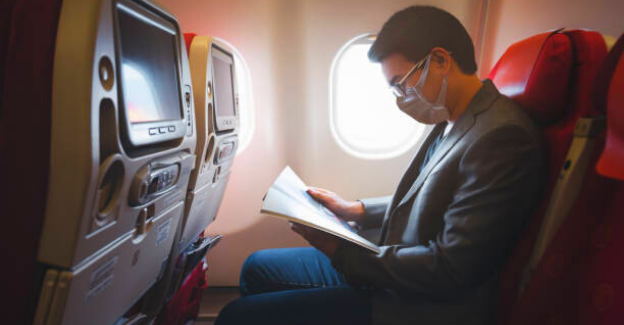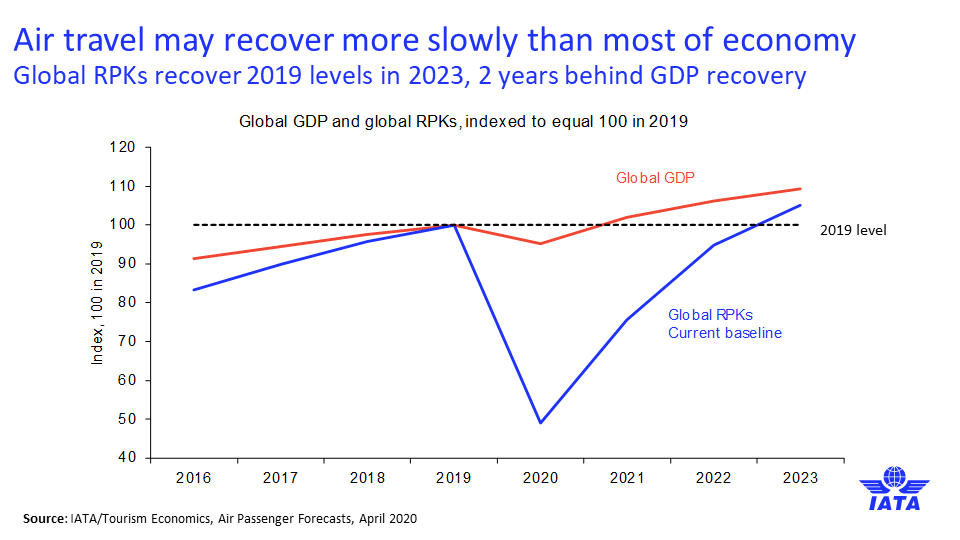Limited Supply, Safety First and New Behaviors.
There’s not likely to be a lot of business travel happening within most of your companies right now. There hasn’t been, globally, for a few months, as corporations introduced blanket travel restrictions from March onwards for all but business-critical or key worker travel.
|
|
But, while the threat of Covid-19 hangs over us, the green shoots of a return to corporate travel are beginning to show through. Still, only 24% of companies we surveyed in June had a plan for a return to travel ready, and the overall prediction for the travel sector isn’t great – so it will take time. IATA predicts that Revenue Per Kilometre (RPKs), a key metric in the airline category, will lag behind GDP until well into the middle of the decade. No doubt you’ve read about the mass changes within the airline sector to accommodate this, never has the industry been so “front page.” The balance of supply versus demand in the travel sector will be complicated as airlines and hoteliers focus efforts on revenue-earning routes rather than fully scaled operations.
What does this mean to you? How will this affect your business need, your value chains and your people?
The days of an unending door-to-door network of travel providers to help your businesses do business while on the move is over for now. The implications for practical travel management and traditional procurement in a COVID-19 world are complex, sensitive and likely to be costly. But while the fast switch to remote working and virtual connections has shown many companies there’s another way to run businesses, the human draw for face-to-face meetings or the practical need for onsite visits will never dampen the demand for business travel completely. Now’s the time to work out the value of the infamous T&E P&L line. For years, travel was seen as a cost without truly understanding the return, now that travel has been taken away, how has this affected your business? Are you still able to grow effectively? Are your employees missing visible leadership? Whatever the reasons, it’s critical that you have a plan for the return to business travel. You need a structured and phased return, with interim policies and operational responses.
In the Short Term - The Permissible Travel Concept
The concept of Permissible Travel is simple, even if the management of a travel program today is not.
Permissible Travel = Company Readiness + Traveler Readiness + Government Permission
Before your company even gets to which suppliers it should use or how safe the destination is, the components of company readiness, traveler readiness and Government permissions need to be tackled first. Over 6,000 companies have accessed the Permissible Travel Framework so far, and policies/programs are beginning to be shaped by different parameters similar to these.
Of course, once policy is set, then operationalizing that with your chosen travel provider is the next step and that’s not to be underestimated either. The complexity of service delivery now required (to enforce policy, find providers, give government guidance and sanitary advice) is challenging, to say the least.
In the Mid-Term – Negotiations Versus Dynamic Market Rates
Industry consensus tells us that rates in each of the business travel sectors will behave differently.
In the air sector, rates will initially be likely to be low to attract travelers and bring cash through the door. But as demand starts to return, social distancing affects revenues and airlines control inventory, the fares will undoubtedly rise to levels not previously seen.
In the hotel space, the inventory is much more fixed, and the savings in operating one or two fewer floors is minimal compared to the overall operating costs, so rates will likely remain low for quite some time.
And in the car sector, demand is already beginning to rise fast as travelers look for transportation methods that permit distancing and self-determination.
So, whatever sourcing strategy companies previously had needs re-thinking. And direct dialogue with suppliers about their appetite and ability to respond to RFP’s is essential. The lure of dynamic rates for the mid-terms seems the right approach for many, given the workload associated with a full sourcing exercise and the likely return in a volatile market. But this should be accompanied with smart data sets that look ahead to spot the need for a return to a fixed rate, based on increasing hotel occupancy etc
For the Long-Term - Time to Reconsider Travel Management Strategy & Servicing
The immediate implications of a more complex travel ecosystem and the need for a move towards a Permissible Travel Programme and the challenge to sourcing right now potentially fogs the more significant issue. The trends in the travel sector, which were already in play have become accelerated, the world-class procurement organizations are looking to understand these changes and adapt accordingly:
- Micro services: Whether it’s the improvement in third-party data providers, the proliferation of re-shopping technologies or new entrant services that tackle niche customer needs such as recruit/guest travel, corporations can increasingly patch together a quilt of niche services in an integrated way to provide the service delivery required.
- API capability: Outside of travel, the use of API’s to connect different technologies is just the norm. Travel has been playing catch up with new airline content or online travel agents pushing their hotel content into corporate booking tool technology, all enabled by these new API “pipes.” COVID-19 is driving faster adoption of APIs to bring products and services to the market quicker.
- Supplier strategies: No longer does any travel supplier, such as an airline or hotel want to show up one dimensionally on a screen, they expect control over their brand at the point of shopping/booking, just like any retail product of the same value (think handbags, watches anything the equivalent value of an airline seat). This is especially important when safety is of paramount importance but will also affect the price paid. Squeezed suppliers = a complete review of all distribution costs, which are likely coming your way.
- Consumer demand: Business travelers are first and foremost consumers. They don’t expect to have one set of slick experiences outside of their company and then a set of clunky service experiences at work. This is now a given, but many companies are yet to catch up prioritizing the employee (maybe a silver lining of COVID-19 will be a significant focus on the “consumer”)
- Organizational demand: The need for control and visibility still exists and in general, expectations of what a managed service looks like are at an all-time high. Simply managing the booking and servicing of a flight, hotel, car or train is no longer enough. Frankly, it was never enough.
Good News
The good news is that as travel managers and buyers within businesses begin to implement Permissible Travel Programs, with travel bookings likely to slowly creep up to the 60% level by year-end, there’s time to take a step back and re-think a number of strategic components, and ask yourself questions like:
- How has our future demand changed? Defining what travel is needed, understanding behavioral change through effective use of virtual communication and the impact of more homeworking on travel, meetings and events is fundamental. Understanding what you’re going to need before you start revising servicing and suppliers is the single most important thing any company can do.
- What type of service structure should we have? There are four emerging travel management servicing models emerging. We detail more about this here.
- Should we outsource travel management? With travel management becoming more complex and the market dynamics creating more and faster change to suppliers and the distribution landscape, the age-old question of outsourcing versus insourced travel management becomes key.
Creating an agile travel program, focused on the safety of travelers and providing all the inventory that’s needed doesn’t have to be at the detriment of cost to the company. But it requires more focus on a category that has the propensity to cause headaches if pre-COVID-19 practices are left to run in a post-COVID-19 world.








